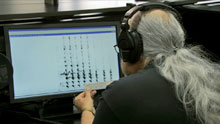For how long have we been laughing? Are human beings the only ones to laugh? In the past, scientists tended to neglect such questions of laughter, leaving them to the philosophers. Jacques Mitsch's A NATURAL HISTORY OF LAUGHTER explores recent scientific attempts to explicate this most elusive of human faculties, undertaken by scientists who see it as a means of approaching some of the larger mysteries of neurology and human behavior.
The investigation begins in the United States with Robert Provine, a neuroscientist and psychologist at the University of Maryland who has devoted his career to the study of the evolution of human laughter and the neural mechanisms that produce it. We follow Provine into the classroom, the lab, and finally, the field - in this case, a college cafeteria - as he explains what his studies of laughter have revealed about the human brain.

But laughter did not begin with humans. The film burrows deeper into its evolutionary origins with Dutch ethologist Jan Van Hoof, another pioneer of the laughter sciences. Van Hoof takes us inside his chimpanzee observation cabin to witness his behavioral experiments with the primates, showing us how he determined what constitutes chimpanzee laughter, and how he distinguishes between different vocalizations and facial expressions.

From these discipline-defining studies, A NATURAL HISTORY OF LAUGHTER expands outwards as Mitsch's scientist subjects track the broader implications of their findings. They leave us with a series of suggestive questions. How do animals experience emotions? Is laughter at the root of human empathy? Does laughter contribute to or indicate overall health?
Prompting these thoughts and many others, this informative film is bound also to make you laugh - but not in the ways you expected.
"The documentary is both intellectually stimulating and emotionally satisfying. It has the potential to be a vocational motivator for high school students, inspiring them to pursue science. For undergraduates, it could support the study of the biological basis of social behavior and boost understanding of concepts in social neuroscience, evolutionary psychology, animal behavior studies, and related subjects. And the film could appeal to the graduate student and professional audience, as they will relate to its revelation of the scientific research process. The film offers clarity for the neophyte science student and complexity for the aspiring or practicing scientist. Because of the interdisciplinary nature of social neuroscience, the documentary has broad potential application across the curriculum, from philosophy to general science. It would be quite effective as a teaching tool about observation, empiricism, and the scientific process."—Educational Media Reviews Online
"Using this presentation as an introduction to the study of the brain in general and laughter specifically can help students see neuroscience in action-all the while LOL. I would use this with secondary students not only to show the relevance of laughter but as a tool to show how scientists do experiments in many studies."—National Science Teachers Association Recommends
2011 FID Marseille
2011 Pariscience
2011 Festival dei Populi
